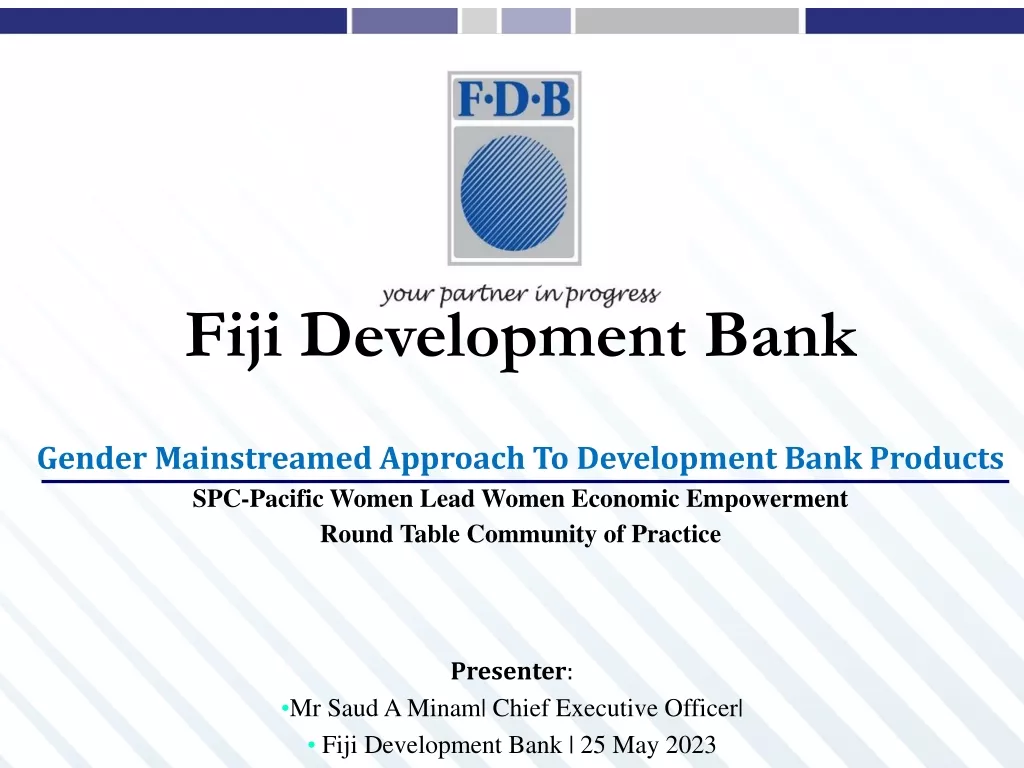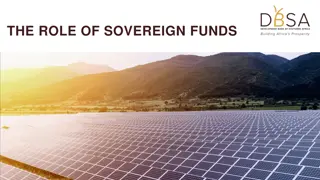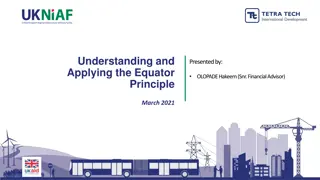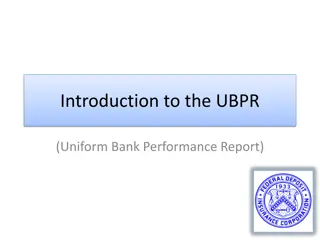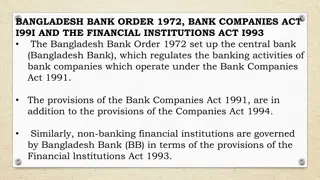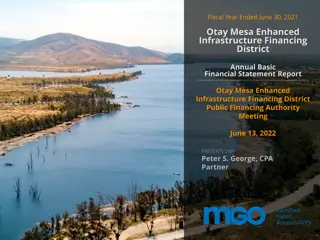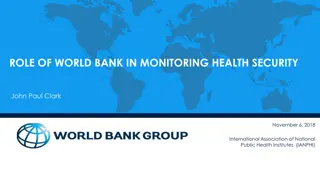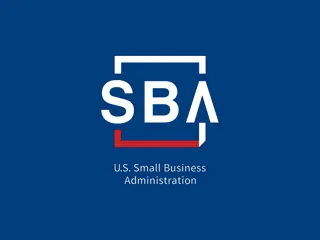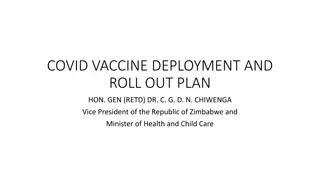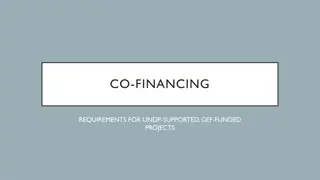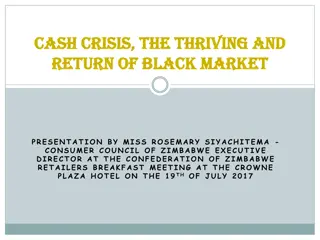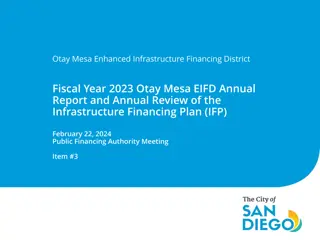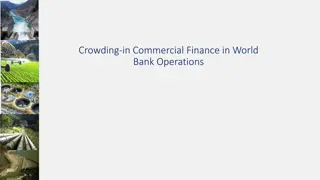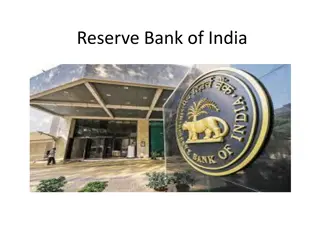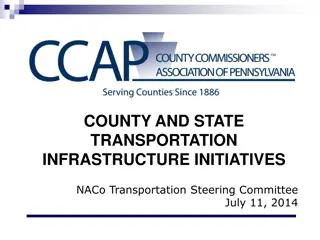Infrastructure Development Bank of Zimbabwe (IDBZ) - Financing Zimbabwe's Infrastructure Needs
The presentation by the Infrastructure Development Bank of Zimbabwe (IDBZ) at the CIFOZ Congress 2018 outlines the critical infrastructure sectors, funding requirements, and the funding gap faced by Zimbabwe. IDBZ is mandated to facilitate infrastructure development in key sectors like ICT, housing, water, energy, and transport. The financing needs for various infrastructure projects in Zimbabwe are substantial, with a significant annual funding gap. The presentation emphasizes the importance of infrastructure expenditure for economic growth and productivity enhancement.
Download Presentation

Please find below an Image/Link to download the presentation.
The content on the website is provided AS IS for your information and personal use only. It may not be sold, licensed, or shared on other websites without obtaining consent from the author. Download presentation by click this link. If you encounter any issues during the download, it is possible that the publisher has removed the file from their server.
E N D
Presentation Transcript
CIFOZ Congress 2018 Presentation by Infrastructure Development Bank of Zimbabwe (IDBZ)
Introduction The Presentation is in two parts: Part A: Introduction and Mandate of IDBZ- 1 Mandate and key sectors: 2 Infrastructure funding requirements 3 Funding Gap 4 Comparisons with other African countries 5 Potential resources in the African context What Zimbabwe need to reverse Part B: Operational issues- 6 1 Role of IDBZ in infrastructure Projects 2 Implementation and Funding arrangements/options 3 Examples of projects 4 Opportunities through the Value Chain.
IDBZ: Mandated to facilitate infrastructure development through resource mobilisation and capacity building in the following Sectors: ICT Housing/Social Infrastructure Water, Irrigation & Sanitation Energy Transport Land development Water & Sewer Roads & drains Electricity reticulation Accommodatio n Electricity Generation Transmission Lines Hydro power Solar Roads Airports Railways Marine Backbone Distribution infrastructure Dams Irrigation Water pipelines
Magnitude Of Financing Requirements For Infrastructure In Zimbabwe- Minimum Gap Analysis Transport US$5.6 B -Roads -Airports -Rail Urban link roads Water & Sanitation US$4.2 B -Dams -Irrigation Treatment Plants -Sewer ICT Housing/Social Infrastrcuture More than 1.2 Million Units -Water & Sewer -Link roads Electricity Water Student/Staff accommodation Energy: US$4.3 B -Power plants -Transmission lines -Renewable Energy -Solar projects US$0.1 B Communica tion systems -Telephones Lines -Internet Services IC Total US$33 B in two decades. Translating to annual gap of US$1.7 billion. The Gap has since widened due to national budgetary constraints Researches including IMF agree that there is a positive & significant relationship between infrastructure expenditure and output, growth and productivity.
Infrastructure funding levels against the requirements o Since 2010 to date the country has been allocating between US$200 Million and US$ 500 Million of public resources towards infrastructure against a financing requirement of over US$1.7 billion leaving a huge funding gap of over US$1.2 billion per year. 6 Actual Expenditure World Bank Estimate 1.7 B 1.7 b 1.7B 1.7B 1.7B 1.7B 1.7B 1.7B Ideal Trend to close the gap 0.5 Bln 0.3 Bln 0.3 Bln 0.3 Bln 0.2 Bln 0.2 Bln 0.1 Bln 0.0 Bln 2009 2010 2011 2012 2013 2014 2015 2016
Comparison between Zimbabwe and selected African countries in terms of infrastructure financing Infrastructure Consortium for Africa (ICA) 2014a 7 Top (e.g. South Africa, Lesotho, Botswana) allocates around 7.5% of their infrastructure. Zimbabwe and such as Sierra allocate around 1.2% of GDP to infrastructure. There is a need to reverse this trend. Zimbabwe should aim to allocate well above 6% of its GDP towards infrastructure in order to close the existing gap. Positive that the Transitional Stabilization aims at increasing the share of resources towards infrastructure. performing countries GDP to countries Leone Programme allocated
Magnitude of resources available for in Africa that Zimbabwe may take advantage of if conditions are created? Possible Funding sources Magnitude (US$) Official Development Assistance (ODA) Over 50 billion (But dwindling) FDI Over 54 billion International reserves 400 billion Diaspora remittances Over 66 billion Private Equity Markets Over 30 billion Potential earning from minerals Over 168 billion Lines of credit from banking sector 60 billion Pension Funds Over 300 billion
Variables that makes Zimbabwe to be perceived as too risky. (Evidence from Africa Competitiveness Report- 2017 9 on a scale (0) to (30) with (o) representing best environment and (30) representing worst case scenario. 25 Policy instability challenges 24.6 Access to Financing challenges 14.5 Corruption related challenges 12.7 20 Inefficient Government Bureaucracy 11.2 Inadequate supply of infrastructure 10.1 15 Restrictive labor regulations 6.4 Tax rates 5.1 Foreign currency regulations 5.1 10 Government Instability 3.3 Insufficient capacity to innovate 2.4 5 Tax regulations 1.8 Inflation 1.3 0 Poor work ethic in national labor force 0.8 Crime and theft 0.5 Inadequate educated workforce 0.1 Poor public health 0
The Role of IDBZ in Infrastructure Projects I. Project Preparation and Packaging: Technical assistance on Feasibility Studies, project structuring, arranging project preparation finance, preparation of marketing/tender documentation (EOIs, RFPs, PIMs, etc.) Project Financing: Determination of suitable financing models, resource mobilization, negotiating funding terms/agreements with investors, administering funding arrangements, etc. Procurement: II. III. The Bank s procurement system is geared towards delivering high quality and value for money goods, works, and services through sustainable cost savings. It seeks to promote fairness, best corporate governance practices and endear public confidence. Project Implementation Monitoring: IV. Contracts management & administration: Validation of Contractor Certificates, handing Disbursements to Contractors/Suppliers, Project Inspections and Progress Reports, etc.
Implementation/Funding Arrangement Options Projects to be implemented through SPV jointly owned by the two parties Joint Venture IDBZ constructs and operates facilities under a concession over a period of time BOT Council sells land to the Bank (particularly for housing projects) Outright Sale Certain revenue streams ring-fenced to repay the loan Loan
Project Development & Preparation Fund (PPDF) I. The Bank recognizes that the lack of bankable projects remains a major challenge which militates against efforts to attract investment towards priority infrastructure projects In response, the Bank established PPDF to finance project preparation and development processes such as layouts, designs, EIA and Feasibility Studies III. Started off with seed capital of US$2.5m but now increased to US$10m II.
Examples of Projects Being Undertaken ProjectPhase Clipsham Views Masvingo Description Servicing of 704 low density stands Project Cost (US$) 6,700,000 Status Completed Bulawayo Students Accommodation Complex ZETDC Prepaid Metering Installation of 800,000 Student Hostels (1032 beds) and commercial centre 12,000,000 Construction in progress 45,000,000 Completed prepaid meters Water and Sewer augmentation Servicing of 340 residential stands Servicing of 2,300 residential stands and rehabilitation of sewer treatment plant Water and Sewer Augmentations Servicing of 1560 mixed density stands Victoria Falls WASH 12,000,000 Resource Mobilisation New Marimba Housing 3,600,000 Completed PHASE 1 Empumalanga West Housing and Sewer Treatment Plant 6,000,000 Construction in progress Chiredzi WASH 9,700,000 Feasibility Studies in progress Construction in progress Kariba Housing 15,000,000
Infrastructure Value Chain Finance (IVCF) About IVCF Infrastructure value chain financing is the provision of financial services and products to the energy, water and sanitation, transport, ICT and housing sector players to address growth constraints. Overall Objective The overall objective of this product is to promote infrastructure development in Zimbabwe by enhancing the capacity of key players in the infrastructure value chain to improve their effectiveness and efficiency in their operations. Specific Objectives to provide working capital and capital expenditure/ asset finance for players in the infrastructure value chain. to support players in the infrastructure value chain by providing bank guarantees (bid bonds, performance bonds, advance payment guarantees, maintenance/ retention bonds). to provide advisory services to players in the infrastructure value chain (business plans and funding proposals).
Infrastructure Value Chain Finance (IVCF) cont d Eligible / Qualifying projects Support will be rendered to players in the energy, water and sanitation, housing, transport and ICT sectors. The eligible activities include: construction and maintenance of road, rail and airport, equipment and materials; water and sewer reticulation; equipment and materials; improvement in existing power generation, transmission and distribution systems; renewable energy equipment (wind, solar, hydro, geothermal, biomass and biogas power projects); housing (roofing materials, cement manufacturing, quarry, bricks and related products); and ICT back bone infrastructure, base stations, mobile money transfer platforms, equipment and related materials. Respect of sustainable development (Climate, gender, social etc) Note The Bank shall NOT fund projects of a re-financing nature. Priority shall be given to those players that are directly involved in infrastructure development. Instruments used to implement the product.
Infrastructure Value Chain Finance (IVCF) cont d The instruments include: structured finance packages; bank guarantees; pre-and post shipment finance to exporters and importers; asset finance; bankers acceptances; bridging loans; working capital short term loans (up to 12 months); capital expenditure medium term loans (up to 24 months); order financing; invoice discounting; and debt factoring. Collaboration Opportunities There is scope for; collaboration with other banks through syndication, and JVs with; municipalities, road authorities, government departments and private sector.
Infrastructure Value Chain Finance (IVCF) cont d Eligibility Criteria The Bank will support those projects that are consistent with the Bank s mandate of infrastructure delivery and lie within the focus sectors. In addition the projects should be financially sound and operating sustainably. The Bank will only lend to projects that are able to service their debts within an agreed time frame. Furthermore, the projects should be socially, economically, technically feasible and environmentally sustainable. In summary, the projects to be supported should fit the following criteria: The beneficiary should have been in business for at least three years; minimum facility thresholds of US$ 100 000; preferably two year audited financial statements or; cash flow projections covering the tenure of the facility; and the firm should be a legal entity registered in Zimbabwe. Tenor Short term 12 months Medium term up to 24 months
Infrastructure Value Chain Finance (IVCF) cont d Pricing Pricing will be guided by the RBZ guidelines on pricing from time to time . However, the Bank ensures that its pricing is competitive, reflective of market conditions. The general conditions are as follows: i. Interest rate - 8% to 10 % p.a.; ii. Arrangement fee - 1.5% to 2% (flat); and iii. Guarantees, the commission is between 1.5% and 2% once off and 0.25% quarterly. How to apply There is need for a business proposal which is in line with the Bank s funding requirements check list available at www.idbz.co.zw or can be obtained from the Bank. The business proposal should be accompanied by an application letter which states the borrower s needs. Customer Due diligence The Bank consider the following when extending to its customers: Adherence to good corporate governance practice; Valid borrowing powers obtained from the responsible authorities/ board resolution; Audited financial statements; Compliance with statutory requirements in the sector; Other Know Your Customer (KYC) considerations; and Compliance with Anti Money Laundering and Terrorist Financing(AMLTF) principles.
Thank you Tatenda Siyabonga Twalumba


